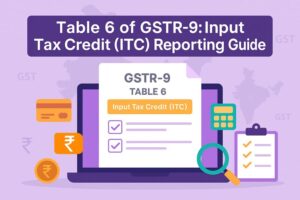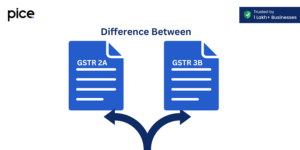Debit Note Under GST
- 6 Sep 24
- 10 mins

Debit Note Under GST
- Understanding a Debit Note
- Format of a Debit Note
- Debit Note in the Context of GST
- Step-by-Step Guide to Creating a Debit Note
- Significance of a Debit Note Under GST Law
- Time Frame for Issuing a Debit Note
- Common Reasons for Issuing a Debit Note
- Procedure for Issuing a Debit Note
- Justifications for Issuing a Debit Note
- The Bottom Line
Key Takeaways
- A debit note is used to correct errors in invoices, especially in B2B transactions, to adjust the taxable value.
- Debit notes are crucial under GST law for ensuring compliance and enabling businesses to claim Input Tax Credit (ITC).
- The debit note must include details such as supplier information, tax amounts, invoice references, and reasons for issuance.
- There are no strict time limits for issuing a debit note, but it must be done before the annual GST return or by 30th September of the next financial year.
- Debit notes help both buyers and sellers maintain accurate records and avoid penalties by ensuring the correct amount of tax is reflected.
Under the Goods and Service Tax regime, knowing the various documentation processes is important for optimising tax benefits. One such document is a debit note. Just like a credit note, it plays a vital role in the correction of invoices and debit adjustment of taxable values. Having a comprehensive knowledge of debit notes helps safeguard the interests of both the buyers and sellers that are involved in a transaction. In this blog, we discuss the aspects of debit note in GST, including its issuance process and purpose.
Understanding a Debit Note
A debit note, also known as a debit memo, is a document that a seller uses to make the buyer aware of present debt obligations. Often, a buyer issues a debit note when they are returning goods that they had bought on credit.
It is essentially used in business-to-business or B2B transactions, which involve a credit extension. Precisely, the buyer receives the goods from the B2B supplier before he completes the total payment.
Unlike invoices, the structure of debit notes is like letters and immediate payments are not mandatory.
Format of a Debit Note
A debit note should contain the following elements:
- Mention 'Debit Note' at the top of the document
- 6-digit unique number of debit note
- Issuance date of debit note
- Supplier’s Tax Identification Number (TIN), name, contact details and address of the supplier
- Name, contact information and unregistered recipient's address of delivery
- Name, contact information, and the delivery address of the registered recipient
- Reference number of the invoice for which the debit note is being issued
- Detailed description of the goods, such as the total price, quantity, etc.
- Amount of tax and the rate of taxation
- Signature of the authorised person issuing the debit note.
💡 If you want to pay your GST with Credit Card, then download Pice Business Payment App. Pice is the one stop app for all paying all your business expenses.
Debit Note in the Context of GST
As per Section 34(3) of the CGST Act, 2017, a registered person is eligible for debit note issuance based on circumstances. Some of those are:
- Tax invoice issuance for the supply of goods and services
- Issue of tax invoice of goods and services but a lower tax rate is charged
- When the quantity supplied exceeds the committed amount of goods and services
Debit note under GST is significant when it is a part of GSTR-1 in the month of supply and the same detail reflects in Form GSTR-2A and GSTR-2B for resident's review and in Form GSTR-3B for submission.
It was previously necessary to quote the original invoice number in Form GSTR-1 and Form GSTR-6 on the official portal of GST. However, here are a few changes that have been observed with the delinking of debit notes from invoices:
- A credit or debit note that is issued for tax rate difference may have its value as zero.
- It is important to provide the location of supply as it helps to differentiate between interstate and intrastate supply.
Step-by-Step Guide to Creating a Debit Note
Follow the steps below for a seamless process of debit note creation:
- Step 1: Mention the date and allocate a unique number.
- Step 2: Include the recipient’s name, contact details and address.
- Step 3: Mention the company’s name, contact details and address at the top.
- Step 4: Provide the purchase order or original invoice’s reference.
- Step 5: Present a description of the goods and services, including details of the quantities, amounts, unit prices, etc.
- Step 6: State a valid reason for the debit note issuance, such as overcharges or non-inclusion of freight charges.
- Step 7: Calculate and mention the total amount of the debit note, and tally it with the description of discrepancies.
- Step 8: Calculate the total amount, with the inclusion of any applicable rates of tax.
- Step 9: Provide your signature and mention valid contact details for future enquiries.
- Step 10: Distribute the debit note to the concerned recipient and keep a copy of the same to maintain records.
Significance of a Debit Note Under GST Law
Under GST law, debit notes play a significant role in various business transactions. Some of them are:
- Claimant to Input Tax Credit: It gives the buyer the right to claim to ITC for the additional increased amount. It is important to remember that ITC must be claimed within the stipulated time.
- Maintaining Correct Records: It allows you to correct discrepancies in original invoices, such as miscalculations. This helps in maintaining accurate, error-free records for both the buyer and seller.
- Ensuring GST Compliance: Note issuance for lawful reasons like revised tax rates allows businesses to comply with tax regulations and adhere to them.
Time Frame for Issuing a Debit Note

Although there is no strict time limit on issuance, it is necessary to issue it within the earliest of these dates:
- On or before the date on which Form GSTR-9 (Annual Return) is filed by the taxpayer for the current financial year
- On or before 30th September of a financial year which follows the year where the taxable supply was made
If you fail to issue a debit note within the given time frame or include it within the monthly return of the following month, you may have to incur penalties and bear increased tax liabilities. Additionally, you must keep the supplementary invoice or debit note for a time of 72 months from the due date of Form GSTR-9 for the concerned year.
Common Reasons for Issuing a Debit Note
Reasons for debit note issuance for a seller and buyer are usually different. Here are a few reasons for issuing a debit note by a seller to a buyer:
- Undercharged amount in the initial invoice
- Additional order of goods or services
- Non-inclusion of any additional charges
Here are a few reasons for a buyer's request for a debit note to the seller:
- Incorrect value stated in the invoice
- Overcharged amount in the initial invoice
- Buyer is dissatisfied with the quality of the goods
- Buyer received damaged or defective products
Procedure for Issuing a Debit Note
Here is a procedure that a supplier may follow for issuing a debit note:
- To initiate a debit note, a supplier first needs to mention the reason. It could be due to wrong calculations, extra charges, revised rates of tax and many more.
- The content of the debit note should contain the complete information of the company including GSTIN, complete information and GSTIN of the recipient, the amended amount including GST and invoice reference.
- Upon completion, the supplier needs to send the debit note to the buyer or recipient.
- During tax reporting, it is necessary to add the debit note in Form GSTR-1 for the month of issuance.
- Once the buyer or recipient receives the debit note, he reviews the amendments thoroughly.
- If the buyer accepts the changes, he can claim an increased Input Tax Credit, which will be reflected in Form GSTR-3B.
Justifications for Issuing a Debit Note
The following are two justifications for issuing a debit note:
- Changes in GST rates: Sometimes it is seen that the rate of GST that was charged during the purchase transaction changes after the issuance of the invoice. In this case, you may issue a debit note to make the necessary corrections in invoices after calculating the new tax rate.
- Error in Invoice: If some major errors were found in the original invoice, like discrepancies in tax rates, a debit note is issued to amend them.
The Bottom Line
Debit note in GST is an essential document used to rectify the errors in invoices and ensure the reflection of accurate records in transactions. Additionally, it helps businesses claim Input Tax credits, comply with tax authorities' regulations and avoid heavy penalties.
 By
By 
















